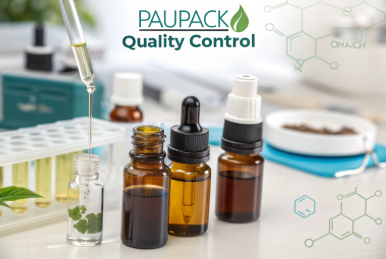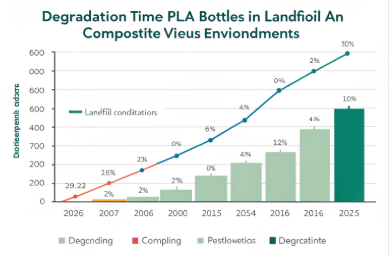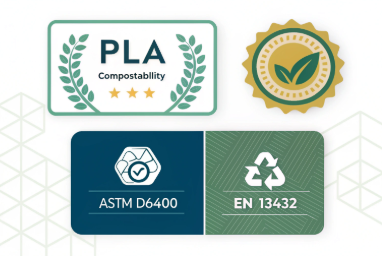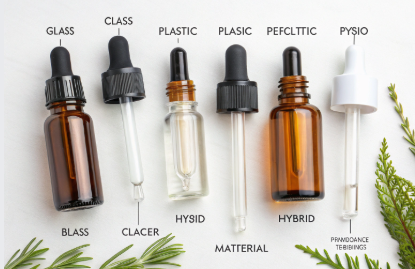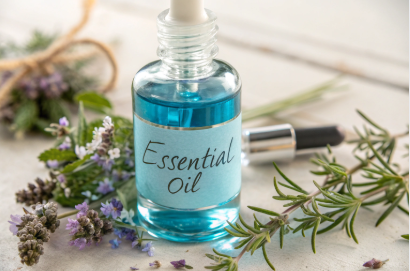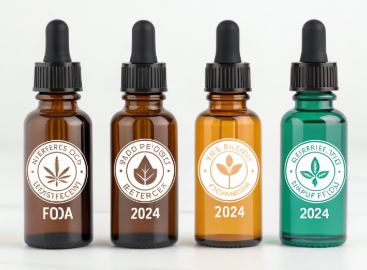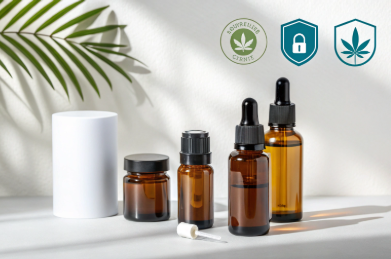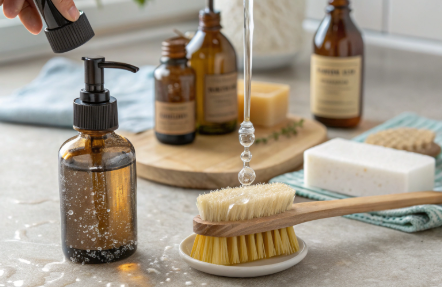PLA (polylactic acid) is marketed as biodegradable—but what does the science say about how fast it breaks down?
Third-party lab tests show that PLA bottles can degrade within 60–120 days in industrial composting conditions, but take much longer in home compost or landfill environments.
Let’s look at the real data, and what it means for your packaging decisions.
What Do Lab Results Say About PLA Bottle Degradation Timeline?
Biodegradability isn’t guesswork—it’s chemistry. And it varies by environment.
According to certified lab tests under ASTM D6400 and EN 13432 conditions, PLA bottles achieve 90%+ biodegradation within 90 days in industrial composting setups.
Summary of Degradation Test Results
| Condition | Time to 90% Degradation | Test Standard | Notes |
|---|---|---|---|
| Industrial Compost (58°C, humidity, oxygen) | 60–90 days | ASTM D6400 | Controlled, optimal conditions |
| Home Compost (25–35°C) | 12–18 months | None standardized | Slower microbial action |
| Landfill (anaerobic, no oxygen) | 20–100+ years | Not applicable | Not degradable here |
| Marine Environment | Minimal | Not recommended | Risk of microplastics |
These results highlight the importance of end-of-life infrastructure. At PauPack, we always educate our clients on the realistic decomposition pathways based on their product distribution region.
How Do Composting Conditions Affect PLA Breakdown Speed?
The environment is everything when it comes to degradation.
PLA requires specific composting conditions—heat, moisture, oxygen, and microbial activity—to break down quickly and fully.
Composting Condition Breakdown
| Factor | PLA Impact |
|---|---|
| Heat (55–60°C) | Activates breakdown enzymes |
| Oxygen | Required for aerobic degradation |
| Moisture (50%+) | Supports microbial growth |
| Microbial Community | Breaks PLA into CO₂, water, biomass |
| Particle Size | Smaller = faster decomposition |
Industrial composting facilities simulate these conditions, allowing PLA bottles to degrade efficiently. PauPack PLA bottles are designed and tested for compostability under these settings, verified by third-party labs in Europe and North America.
Can PLA Bottles Degrade in Landfills or Natural Environments?
This is a common misconception.
No—PLA does not degrade in landfills, and breaks down very slowly in soil or oceans, potentially contributing to microplastic pollution if not properly disposed.
Breakdown by Environment
| Environment | Degradation Timeline | Risk |
|---|---|---|
| Landfill | 50–100+ years | Anaerobic = no breakdown |
| Buried in Soil | 1–5 years | Incomplete degradation |
| Freshwater or Ocean | 20+ years | Similar to PET in behavior |
| Home Compost (cold) | 1–2 years | Varies by climate |
That’s why proper disposal messaging is key. At PauPack, we include:
-
“Industrial compost only” icons
-
QR codes for disposal info
-
Region-specific labeling for EU/US/Asia
We also help brands integrate refill programs or recyclable PCR caps for a more circular packaging system.
How PauPack Designs PLA Bottles for Functional Use and Safe Decomposition?
Eco doesn't mean flimsy—and biodegradable doesn’t mean untested.
PauPack PLA bottles are engineered for durability during use, and safe degradation after proper disposal, balancing product protection with sustainability.
Our PLA Bottle Specs
| Feature | Benefit |
|---|---|
| Wall thickness 1.0–1.5mm | Durable for filling, capping, transport |
| Heat limit ~55°C | Safe for skincare, oils, serums (not hot-fill) |
| Custom-fit caps (PP/PCR/bamboo) | Sealed system, modular disposal |
| Surface options | Matte, frosted, or printed PLA available |
| Industrial compostable certification | ASTM D6400, EN 13432 validation on request |
We also test all bottle-cap combinations under accelerated aging, torque stress, and temperature fluctuation to ensure zero leaks and shelf-life reliability.
How Brands Can Communicate PLA Sustainability Without Greenwashing?
Honest storytelling is now essential.
Consumers and regulators expect brands to back up sustainability claims with science, clarity, and regionally accurate information.
Smart Messaging for PLA Packaging
| Message | Why It Works |
|---|---|
| “Compostable in industrial settings” | Truthful, avoids misleading home claims |
| “Bioplastic made from renewable plants” | Adds value beyond end-of-life |
| “Carbon footprint up to 80% lower than PET” | Backed by LCA data |
| “Disposal instructions available via QR” | Helps educate without cluttered labels |
At PauPack, we offer label templates, disposal icons, and storytelling copy to help brands position their PLA bottles with integrity and impact.
Why PLA Bottle Lifespan Depends on Use Case and Disposal Path?
PLA’s eco-appeal depends entirely on how it’s used and discarded.
A PLA bottle will remain fully intact for over a year on a store shelf—but degrade within months under the right composting conditions.
This dual behavior makes PLA ideal for:
-
Shelf-stable products like serums, toners, essential oils
-
Brands selling in markets with composting access
-
Packaging that supports a short lifecycle or refill model
But it also means that:
-
Misuse (like landfill disposal) eliminates most of its sustainability benefit
-
Shelf storage in hot or humid conditions must be avoided
At PauPack, we help brands evaluate PLA's suitability based on product lifespan, temperature exposure, and geographic disposal access—ensuring function and responsibility coexist.
What the Latest Data Tells Us About PLA vs PET End-of-life Impact?
It’s not enough to say “biodegradable”—you need to know the lifecycle footprint.
Lifecycle assessments show that PLA emits up to 70% less carbon than PET, but offers no degradation advantage in landfills or oceans.
End-of-life Performance Comparison
| Feature | PLA | PET |
|---|---|---|
| Compostable (Industrial) | Yes (90 days) | No |
| Recyclable (Curbside) | Limited | Yes |
| Degrades in Soil/Water | Slowly | Not at all |
| Carbon Emission | Low | High |
| Circularity Support | Compost route | Mechanical recycling |
That’s why PauPack often recommends hybrid strategies: PLA bottles with PCR PET caps or modular refill packaging that encourages reuse before disposal.
How PauPack Ensures PLA Bottles Stay Stable on Shelf, Not in Soil?
PLA should decompose—eventually. But first, it must protect your product.
PauPack tests all PLA bottles for thermal tolerance, UV exposure, and sealing integrity to ensure 12–18 month shelf life without risk of premature softening, leaking, or warping.
Shelf-stability Features We Include
-
UV-inhibited PLA resin for clarity + sun resistance
-
1.2–1.5mm wall thickness to resist handling damage
-
PCR or PP cap compatibility for moisture control
-
Label-free or laser-engraved branding to reduce material layer complexity
We simulate long-term storage with accelerated aging chambers (45°C, 75% RH) and shipping vibration + inversion tests to ensure your PLA packaging performs like plastic—until it’s time to disappear.
What Role Do Certifications Play in Verifying Biodegradability Claims?
Consumers are skeptical—and regulators are watching.
Third-party compostability certifications like ASTM D6400, EN 13432, or BPI prove that your PLA bottles truly degrade under industrial conditions.
These standards require:
-
90%+ biodegradation in <180 days
-
Zero toxic residue
-
Disintegration into <2mm fragments in compost
At PauPack, we provide:
-
PLA material certifications
-
Bottle-level compostability test reports (on request)
-
Verified resin sources from certified biopolymer suppliers
This documentation supports your labeling, retailer submissions, and sustainability reports—making your claims compliant, not just catchy.
How Brands Can Build Smarter Product Lines with PLA Packaging?
PLA isn’t for every formula—but it’s perfect for certain SKUs.
Smart brands use PLA bottles for products that are low-viscosity, short-use, and well-aligned with green consumer expectations.
PLA Use Case Fit
| Product Type | PLA Fit? | Why |
|---|---|---|
| Toners / Facial Mist | ✅ | Low heat, high rotation |
| Hair Serums | ✅ | Minimal oil, stable formula |
| Room Sprays | ✅ | Eco-conscious positioning |
| Essential Oils | ⚠️ | Use with PP cap, test chemical compatibility |
| Sunscreens / SPF | ❌ | Requires long shelf life + heat resistance |
PauPack helps you match product profile to material—and offers pre-tested PLA molds that reduce your MOQ while staying certified. Whether you're launching in eco retail or exploring refill models, we help you build smarter with fewer trade-offs.
Conclusion
PLA bottles offer a compostable solution with clear benefits—but only when matched with the right product, market, and disposal plan. PauPack provides science-backed PLA packaging designed to work today—and disappear tomorrow.




